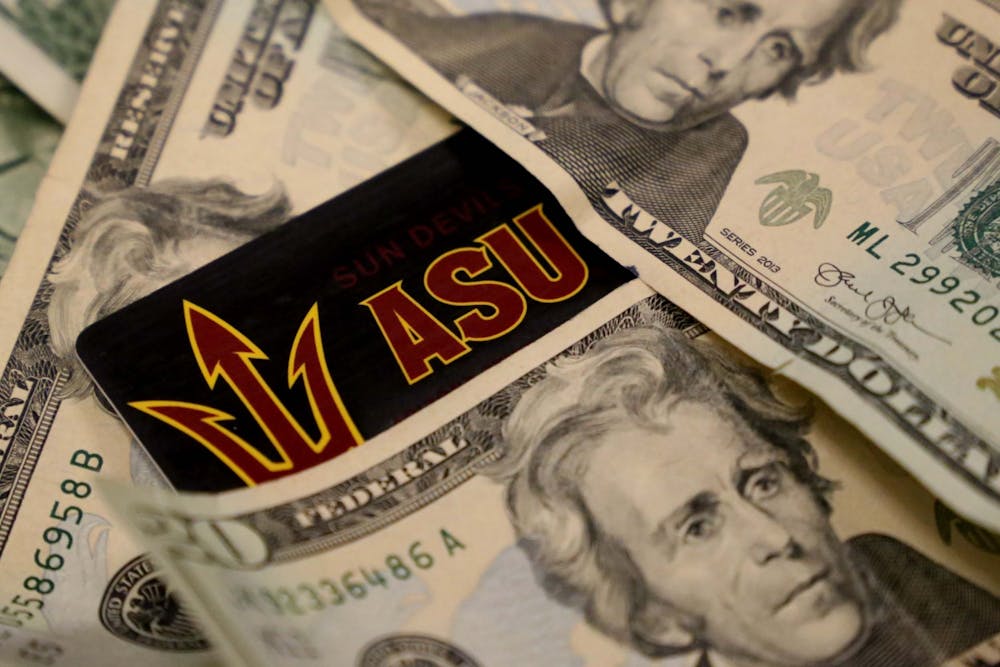ASU Executive Vice President, Treasurer and Chief Financial Officer Morgan Olsen said in a meeting last week with The State Press the University's net position, a figure that indicates whether an institution is funded enough to pay the costs of its services, stood at $1.6 billion.
ASU's net position increased by about $248 million since the last fiscal year. Olsen said the biggest component of the $1.6 billion came from investment in University buildings and other physical assets. The University's net position consists of all of the University's assets, including buildings, land and more, subtracted by its liabilities such as debts.
In the meeting, Olsen also discussed the University's financial position as the COVID-19 pandemic slows, proposed tuition increases and plans for more student housing.
Tuition increases
On March 7, ASU President Michael Crow submitted his tuition and fee proposal to the Arizona Board of Regents. In it, he proposed a 2.5% increase in tuition for on-campus resident students, a 4% increase for non-resident students and a 5% increase for international students for the 2022-23 academic year.
READ MORE: ASU President Michael Crow proposes tuition increases for 2022-23 academic year
The proposal marks the University's first time asking for significant changes to tuition since the COVID-19 pandemic began roughly two years ago. If unchanged and approved by ABOR, the change will stay within the University's mission to keep increases for resident students below 3%.
High inflation and students returning to campus for in-person instruction impact the cost of attendance for all students, Olsen said.
"We have to look longer term at what the University's financial requirements are going to be and the services that people expect us to provide," Olsen said. "We have to make sure that we have long term financial equilibrium, kind of a balance between revenue and expense."
As enrollment at the University continues to increase, Olsen said tuition revenue will be used to hire more faculty and to fund support areas like counseling, financial aid and career development services on campus.
Operating cash
The largest part of the University's income is revenue from tuition and fees. This "one big operating cash pool," as Olsen called it, has seasonality — there are a lot of expenses during the year and an inflow period before the start of the fall semester. Olsen said the University will collect about $2.2 billion in tuition and fee revenue that will go toward its biggest expense: payroll.
Olsen said there's an "internal economy that goes on with the institution" with units across the University that manage their own operations and expenses.
Student housing
It takes time for new housing to be built, but Olsen said more housing is on the horizon for the Polytechnic, West and Tempe campuses.
READ MORE: Students move into new Downtown Phoenix dorm
"We've got capacity for roughly 16,000 students in ASU Housing right now," Olsen said. "We would like to grow that over time to about 25,000 students. The main thing that would mean from where we are today is that more upper division undergraduate students would be able to live on campus beyond their first year."
Olsen said the increased capacity will be made possible by expanding the number of residence halls, an undertaking he said costs hundreds of millions of dollars. The University already has public-private partnership development for housing, a way for outside contractors to design and build student living spaces to ASU's specifications.
Russian holdings
In early March, ABOR ordered presidents at the state's three public universities to sell Russian investments quickly due to the ongoing war in the region against Ukraine.
Olsen said the ASU Foundation had equity and some fixed-income investments in Russian assets in commingled funds, similar to a mutual fund where an organization invests money and another puts it in stocks and bonds.
"Russia has been known as an emerging market, which means that it's not as mature and established an economy as the U.S., or Great Britain or France, et cetera," Olsen said. "And so by virtue of those indices, we had about $2.4 million roughly of investment in these commingled funds."
He said investment in a different type of market diversifies the University's portfolio to provide a better return over time. The Russian stock market hasn't been open in two weeks and no one knows when it will open again.
"It's physically impossible right now to sell those stocks," Olsen said.
Correction: This story was updated on March 18 at 8:08 p.m. to correct ASU’s net position.
Reach the reporter at pjhanse1@asu.edu and follow @piperjhansen on Twitter.
Like The State Press on Facebook and follow @statepress on Twitter.

Piper Hansen is the digital editor-in-chief at The State Press, overseeing all digital content. Joining SP in Spring 2020, she has covered student government, housing and COVID-19. She has previously written about state politics for The Arizona Republic and the Arizona Capitol Times and covers social justice for Cronkite News.




